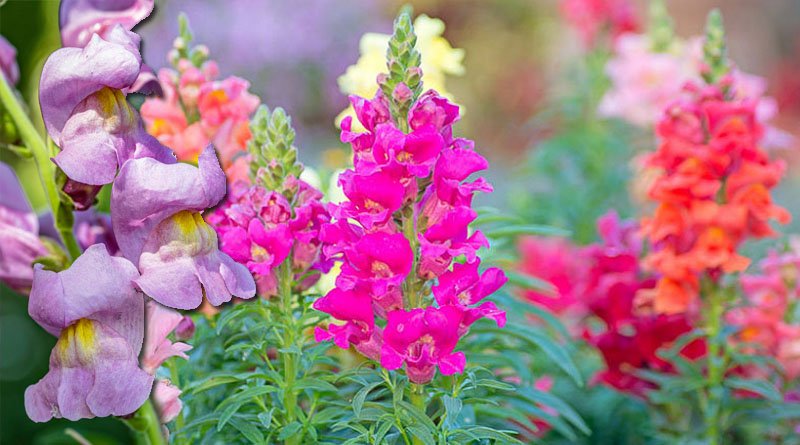The foliar application of boron not only play important role in flower but, however, in different fruit plants and in vegetable, increasing vegetative and reproductive growth in plants

When boron (B) demands exceed what the soil can supply, foliar application may be used to supply B to a crop, while B foliar sprays have been used to treat sunflower B deficiency.
Snapdragon (Antirrhinum majus) is a member of the family Scrophulariaceae. It originated in the Mediterranean region and was later classified as a member of the Plantaginaceae family. There are 20,000 cultivars of the 36 species of antirrhinum that have been identified now. Due to its hinged flowers, which open and close like the mouth of a dragon when compressed at the sides with the thumb, it is called the Snapdragon.
Based on their vegetative growth and flowering responses to photoperiod and temperature, the classification of its cultivars is taking place. Antirrhinum majus has been found to have a lot of different compounds, such as flavanones, flavones, cinnamic acids, aurones, flavanols, pigments, oils, amino acids, anthocyanidins, and many more.
There are more than 140 countries that grow horticultural crops worldwide. In floriculture, for the excellent production of flowers, mixtures are the most important factors. Yield and quality of horticultural crops are strongly affected by poor nutrient uptake. The role of zinc, calcium, and boron is very important among the large number of nutrients, including both macro- and micronutrients.
The effective application of fertilizers in agricultural systems seeks to boost crop output. However, timing fertilizer applications according to crop needs proved challenging.
Foliar fertilizer application has grown in popularity as a frequent method of feeding mulberry fruit trees nutrients due to the capacity of plant leaves to hold nutrient content.
Due to the physiological and important roles that elements like phosphorus, nitrogen, zinc, copper, boron, and potassium play in stimulating and helping to promote vigorous plant growth and development, manure application rates, uniform fertilizer allocation, and a quick response to foliar fertilization became beneficial.
Due to their small-quantity requirements for plant development and production, micronutrients like Zn, Fe, Manganese, Copper, and Boron are not only basic but also essential.
Distribution
Algeria, Libya, Morocco, Tunisia, Palestine, Lebanon, Syria, Iraq, Turkey, Albania, Croatia, Greece, Italy, Malta, Serbia, France, Portugal, and Spin all received distributions of it. It were now regularly produce in gardens in temperate climates in a range of colors and habits.
Climate & Soil
Snapdragons prefer nutrient-rich, well-draining soil with a pH balance of 6.5to 7.5. They really are not heavy feeders because they are short-lived plants, but adding organic materials will keep them flowering and healthy.
Although they can bloom repeatedly all through the year, snapdragons thrive in the chill of fall and spring. They occasionally bloom all through the winter in milder climes, where they occasionally blossom all summer long in cooler ones.
In Pakistan, both soil and climate are ideal for the cultivation of snapdragon flowers. Soils are rich with nutrients, and climates are favorable for this.
Medically Importance
- It has been historically utilized as a stimulant, a detergent, astringent, and to treat tumors, syphilis, liver problems, and liver illnesses.
- Both leaves and blossoms are use as antiphlogistics, resolvents, and stimulants.
- They are also applies as poultices to ulcers and tumors. Its herb is also used to treat various types of inflammation and hemorrhoids.
Major Insect & Pest
- Snapdragons can suffer greatly from rust fungus. It is advisable to plant snapdragons in a different area of such garden the coming year if rust does occur in a planting. Mold, fungal leaf spots, powdery mildew, wither and die, and root rots can all affect this plant.
- The most frequent insect issues are aphids and spider mites, which in cases of significant infestations may call for the application of insecticides or horticultural oils.
Boron Application
According to the periodic table, the metalloid boron belongs to in-group 13. Its mass number is 10.811 g/mol, and its atomic number is five. The chemical symbol for boron is B. Sir Humphry Davy, Gay-Lussac and Thénard discovered it for the first time in 1808.
Since its discovery, boron has been accepted as a necessary element for a number of organisms. Boron is important for the breakdown of nucleic acids, carbohydrates, and proteins. It is also needed to make cell walls, keep membranes working and alive, and break down phenol. B plays important roles in plants, i.e., expanding organs.
Due to this reason, the expanding organs mainly show symptoms of boron deficiency. It results in altered cytoskeleton polymerization, the formation of abnormal cell walls, and changes in plasma membrane permeability. Fruit and flower development, leaf expansion, and root elongation are inhibited.
Results and Discussion
I did different foliar applications of boron on snapdragon flowers (0%, 0.25%, 0.5%, 0.75%, and 1%). All had good results in the plant’s growth, leaves, chlorophyll content, and flower stalk production. The foliar application of boron plays an important role not only in flowers but, however, in different fruit plants and in vegetables, increasing vegetative and reproductive growth in plants. In fruit plants, they increase the fruit’s size and quality. If we increase the percentage of foliar applications, we can get very effective results and improve the plant’s growth and quality.
In boron applications, we can use different micronutrients such as zinc, potassium, and calcium. They are very effective and have no side effects on the environment. In my research, all the results are promising, increasing the plant and flower stalk height. We can achieve good results in various horticulture crops by increasing the percentage of foliar application.
